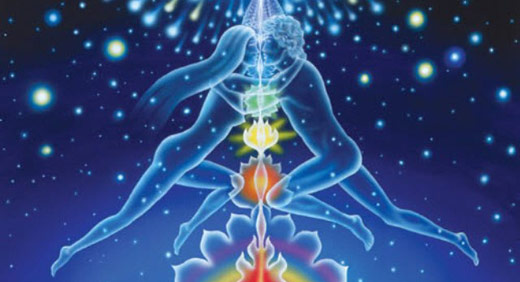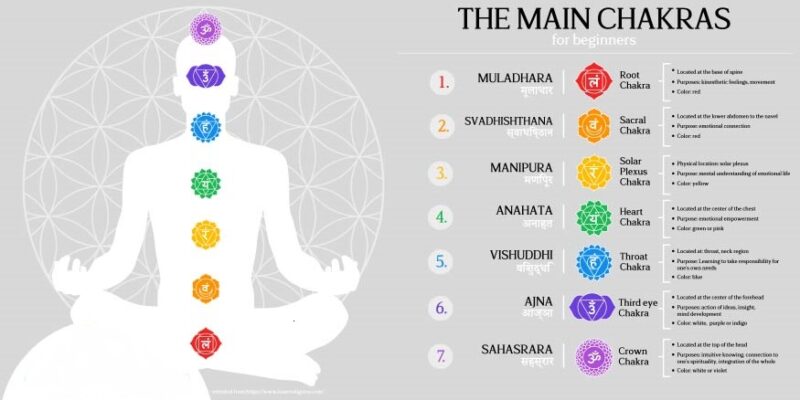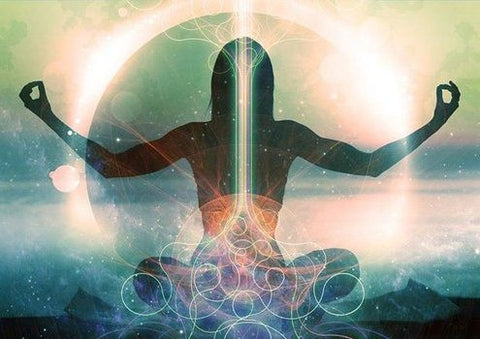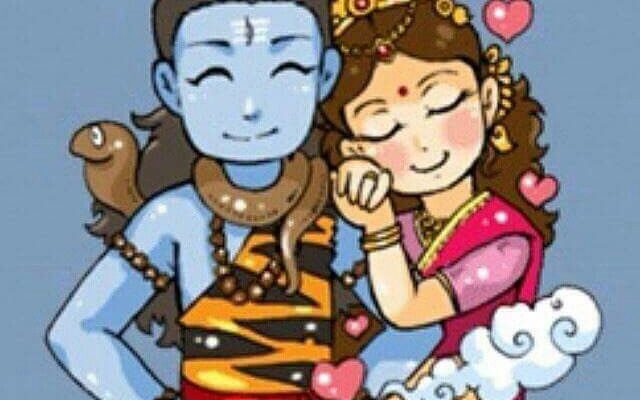When the being is at ajna chakra, point between eye brows, source of creation appears as a star that is…
Vama Marga Tantra

Excerpt from Satyananda Saraswati book “Kundalini Tantra“
Sexual life has always been a problem for mankind. From the beginning of history, the primal energy has been misunderstood. Religious teachers and moralists have denounced it. But still sexual life has continued, not because man respects it, but because he needs it. He may give it up, but he cannot remove it from his mind, for this is one of his most powerful urges.
In the context of yoga and tantra the common definition of sexual life has no relevance. It is absolutely unscientific and incorrect. This definition has created a society and a nation of hypocrites. It has led thousands of young people into mental asylums. When you want something which you think is bad, all kinds of guilt complexes arise. This is the beginning of schizophrenia, and all of us are schizophrenic to some extent.
Therefore, the yogis have tried to give a correct direction to the sexual urge. Yoga does not interfere with sexual life. Normal sexual life is neither spiritual nor aspiritual. But if you practise yoga and master certain techniques, then sexual life becomes spiritual. Of course, if you lead a celibate life, that is spiritual too.
Left Hand Tantra
The science of tantra has two main branches, which are known as vama marga and dakshina marga. Varna marga is the left path which combines sexual life with yoga practices in order to explode the dormant energy centers. Dakshina marga is the right path of yoga practices without sexual enactment. Previously, due to the barriers in sexual life, the path most widely followed was dakshina marga. Today, however, these barriers are rapidly being broken, and the path most sought after by the people everywhere is vama marga, which utilizes sexual life for spiritual development.
According to tantra, sexual life has a threefold purpose. Some practise it for procreation,others for pleasure, but the tantric yogi practises it for samadhi. He does not hold any negative views about it. He does it as a part of his sadhana. But, at the same time, he realizes that for spiritual purposes, the experience must be maintained. Ordinarily this experience is lost before one is able to deepen it. By mastering certain techniques, however, this experience can become continuous even throughout daily life. Then the silent centers of the brain are
awakened and they start to function all the time.
The Energy Principle
The contention of vama marga is that the awakening of kundalini is possible through the sexual interaction between man and woman. The concept behind this follows the same lines as the process of fission and fusion described in modern physics.Man and woman represent positive and negative energy. On a mental level they represent time and space. Ordinarily, these two forces stand at opposite poles. During sexual interaction, however, they move out of their position of polarity, towards the center. When they come together at the nucleus or central point, an explosion occurs and matter becomes manifest. This is the basic theme of tantric initiation.
The natural event that takes place between man and woman is considered as the explosion of the energy center. In every speck of life, it is the union between the positive and negative poles that is responsible for creation. At the same time, union between the positive and negative poles is also responsible for enlightenment, and the experience which takes place at the time of union is a glimpse of the higher experience.
This subject has been thoroughly discussed in all the old scriptures of tantra. Actually, more important than the energy waves that are created during the mutual union, is the process of directing that energy to the higher centers. Everybody knows how this energy is to be created, but nobody knows how to direct it to the higher centers. In fact, very few people have a full and positive understanding of this natural event which almost everybody in this world experiences. If the conjugal experience, which is generally very transitory, could be extended for a period of time, then the experience of enlightenment would take place.
The elements that are brought together in this process of union are known as Shiva and Shakti. Shiva represents purusha or consciousness and Shakti represents prakriti or energy. Shakti, in different forms, is present in all creation. Both material and spiritual energy are known as Shakti. When the energy moves outwardly, it is material energy and when it is directed upwards it is spiritual energy. Therefore, when the union between man and woman is practised in the correct way, it has a very positive influence on the development of spiritual awareness.
Retaining the Bindu
Bindu means a point or a drop. In tantra, bindu is considered to be the nucleus, or the abode of matter, the point from which all creation becomes manifest. Actually, the source of bindu is in the higher centers of the brain. But due to the development of emotions and passions, bindu falls down to the lower region where it is transformed into sperm and ova. At the higher level, bindu is a point. At the lower level, it is drop of liquid, which drips from the male and female orgasm.
According to tantra, preservation of the bindu is absolutely necessary for two reasons. Firstly, the process of regeneration can only be carried out with the help of bindu. Secondly, all the spiritual experiences take place when there is an explosion of bindu. This explosion can result in the creation of a thought or of anything. Therefore, in tantra, certain practices are recommended by which the male partner can stop ejaculation and retain the bindu.
According to tantra, ejaculation should not take place. One should learn how to stop it. For this purpose, the male partner should perfect the practices of vajroli mudra as well as moola bandha and uddiyana bandha. When these three kriyas are perfected, one is able to stop ejaculation completely at any point of the experience.
The sexual act culminates in a particular experience which is reached only at the point of explosion of energy. Unless the energy explodes, the experience cannot take place. But this experience has to be maintained, so that the energy level remains high. When the energy level falls ejaculation takes place. Therefore, ejaculation is avoided, not so much to preserve the semen, but because it causes a depression in the level of energy.
To make this energy travel upwards through the spine, certain hatha yoga kriyas have to be mastered. The experience which is concomitant of energy has to be raised to the higher centers. It is only possible to do this if you are able to prolong and maintain that experience. As long as the experience continues, you can direct it to the higher centers. But as soon as the energy level undergoes depression, ejaculation will inevitably take place.
Ejaculation brings down the temperature of the body and at the same time, the nervous system undergoes depression. When the sympathetic and parasympathetic nervous systems undergo depression, it affects the brain. That is why many people have mental problems.
When you are able to retain the semen without ejaculating at all, the energy in the nervous system and the temperature in the whole body are maintained. At the same time, you are free from the sense of loss, depression , frustration and guilt. Retention will also help to increase the sexual frequency, and that is better for both partners. The sexual act does not have to create weakness or dissipate the energy, on the contrary, it can become a means of exploding the energy. Therefore, the value of retaining the bindu should not be underestimated.
In hatha yoga there are certain practices which must be perfected for this purpose. You should begin with asanas such as paschimottanasana, shalabhasana, vajrasana, supta vajrasana and siddhasana. These are beneficial as they place an automatic contraction on the lower centers. Sirshasana is also important because it ventilates the brain so that all of one’s experiences will be healthy experiences. When these postures have been mastered, shambhavi mudra is perfected in order to hold the concentration steadily at bhrumadhya. Then vajroli mudra has to be practised together with moola bandha and uddiyana bandha in kumbhaka.
Practice of kumbhaka is necessary while the ejaculation is being held. Retention of the breath and the bindu go hand in hand. Loss of kumbhaka is loss of bindu, and loss of bindu is loss of kumbhaka. During kumbhaka, when you are maintaining the experience, you should be able to direct it to the higher centers. If you are able to create an archetype of this experience, perhaps in the form of a serpent or a luminous continuity, then the result will be fantastic. So, in spiritual life, bindu must be preserved at all costs.
The Female Experience
In the female body, the point of concentration is at mooladhara chakra, which is situated at the cervix, just behind the opening of the uterus. This is the point where space and time unite and explode in the form of an experience. That experience is known as orgasm in ordinary language, but in the language of tantra it is called an awakening. In order to maintain the continuity of that experience, it is necessary for a buildup of energy to take place at that particular bindu or point. Usually this does not happen, because the explosion of energy dissipates throughout the body through the sexual medium. In order to avoid this, the woman must be able to hold her mind in absolute concentration on that particular point. For this, the practice is known as sahajoli.
Actually, sahajoli is concentration on the bindu, but this is very difficult. Therefore, the practice of sahajoli, which is the contraction of the vaginal as well as the uterine muscles, should be practised over a long period of time.
If girls are taught uddiyana bandha at an early age, they will perfect sahajoli quite naturally with time. Uddiyana bandha is always practised with external retention. It is important to be able to perform this in any position. Usually it is practised in siddhayoni asana, but one should be able to do it in vajrasana or the crow posture as well. When you practise uddiyana bandha, the other two bandhas – jalandhara and moola bandha occur spontaneously.
Years of this practice will create a keen sense of concentration on the correct point in the body. This concentration is more mental in nature, but at the same time, since it is not possible to do it mentally, one has to start from some physical point. If a woman is able to concentrate and maintain the continuity of the experience, she can awaken her energy to a high level.
According to tantra, there are two different areas of orgasm. One is in the nervous zone, which is the common experience for most women, and the other is in mooladhara chakra. When sahajoli is practised during maithuna (the act of sexual union), mooladhara chakra wakes up and the spiritual or tantric orgasm takes place.
When the female yogi is able to practise sahajoli for say 5 to 15 minutes, she can retain the tantric orgasm for the same period of time. By retaining this experience, the flow of energy is reversed. Circulation of blood and sympathetic parasympathetic forces move upward. At this point, she transcends normal consciousness and sees the light. That is how she enters the deep state of dhyana. Unless the woman is able to practise sahajoli, she will not be able to retain the impulses necessary for the tantric orgasm, and consequently she will have the nervous orgasm, which is short-lived and followed by dissatisfaction and exhaustion. This is often the cause of a woman’s hysteria and depression.
So, sahajoli is an extremely important practice for women. In uddiyana, nauli, naukasana, vajrasana and siddha yoni asana, sahajoli comes naturally.
The practice of amaroli is also very important for married women. The word amaroli means ‘immortal’ and by this practice one is freed of many diseases. The practice of amaroli over a prolonged period also produces an important hormone known as prostaglandin which destroys the ova and prevents conception.
Tantric Guru
Just as in the scheme of creation, Shakti is the creator and Shiva the witness of the whole game, in tantra the woman has the status of guru and the man of disciple. The tantric tradition is actually passed on from the woman to the man. In the tantric practice, it is the woman who initiates.
It is only by her power that the act of maithuna takes place. All preliminaries are done by her. She puts the mark on the man’s forehead and tells him where to meditate. In ordinary interaction, the man takes the aggressive role and the woman participates. But in tantra, they switch roles. The woman becomes the operator and the man her medium. She has to be able to arouse him. Then, at the right moment, she must create the bindu so he can practise vajroli. If the man loses his bindu, it means that the woman has failed to carry out her functions properly.
In tantra it is said that Shiva is incapable without Shakti. Shakti is the priestess. Therefore, when vama marga is practised, the man must have an absolutely tantric attitude towards the woman. He cannot behave with her as men generally do with other women. Ordinarily, when a man looks at a woman he becomes passionate, but during maithuna he should not. He should see her as the divine mother, Devi, and approach her with an attitude of devotion and surrender, not with lust.
According to the tantric concept, women are more endowed with spiritual qualities and it would be a wise thing if they were allowed to assume higher positions in social affairs. Then there would be greater beauty, compassion, love and understanding in all spheres of life. What we are discussing here is not patriarchal society versus matriarchal society, but tantra, particularly left hand tantra.
Path of Yogis not Bhogis
In tantra, the practice of maithuna is said to be the easiest way to awaken sushumna, because it involves an act which most people are already accustomed to. But, frankly speaking, very few are prepared for this path. Ordinary sexual interaction is not maithuna. The physical act may be the same, but the background is totally different.
In the relationship between husband and wife, for example, there is dependency and ownership, but in tantra each partner is independent, one unto himself. Another difficult thing in tantric sadhana is cultivating the attitude of passionlessness. The man has to virtually become brahmacharya in order to free the mind and emotions of sexual thoughts and passion which normally arise in the presence of a woman.
Both partners must be absolutely purified and controlled internally and externally before they practise maithuna. This is hard for the ordinary person to comprehend because for most people, sexual interaction is the result of passion and physical or emotional attraction, either for progeny or pleasure. It is only when you are purified that these instinctive urges are absent. This is why, according to tradition, the path of dakshina marga must be followed for many years before the path of vama marga can be entered. Then the interaction of maithuna does not take place for physical gratification. The purpose is very clear – awakening of sushumna, raising the kundalmi energy from mooladhara chakra, and exploding the unconscious areas of the brain.
If this is not clear when you practise the kriyas and sushumna becomes active, you will not be able to face the awakening. Your head will get hot and you will not be able to control the passion and excitement, because you have not tranquilized your brain.
Therefore, in my opinion, only those who are adepts in yoga qualify for vama marga. This path is not to be used indiscriminately as a pretext for self-indulgence. It is meant for mature and serious minded householder sadhakas, who are evolved, who have been practicing sadhana to awaken the energy potential and to attain samadhi. They must utilize this path as a vehicle of awakening, otherwise it becomes a path of downfall.



